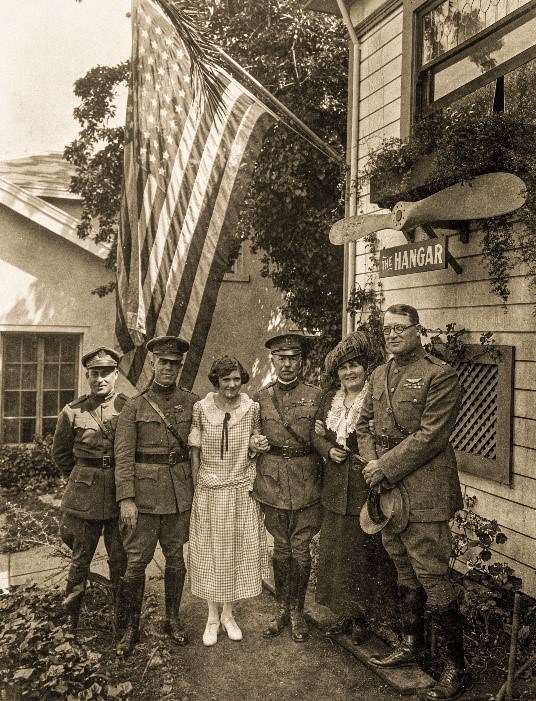|
Crissy Field, circa 1920s. PARC, GGNRA. Crissy Field Established in 1921In 1921, the U.S. Army established the Crissy Field Air Service Coast Defense Station the only military airfield on the west coast specifically built as a coast defense air station. The Crissy Field pilots of the 91st Observation Squadron provided assistance to the on-the-ground Coast Artillery soldiers by flying overhead, spotting and ensuring the batteries’ fire and target practice. The army constructed several airplane hangars, large buildings that offered protected storage space for the planes as well as an assembly area for airplane maintenance. Even though the army chose Crissy Field for its excellent strategic location, the site posed many flying challenges: the notorious San Francisco wind and fog made take-off and landings treacherous and the landing field itself, unsurfaced until the late 1930s, was flooded and muddy during the winter rains and dusty in the summer. Land and Sea Plane HangarsThe army constructed hangar buildings and other maintenance facility buildings all along the edges of the airstrip. In 1921, they constructed hangar buildings 926 and 937 at the west end of Crissy Field, both large enough to accommodate up to 16 planes at a time. Each of the 17,000 square foot steel and concrete structures had huge, barn-like doors that faced the airstrip and a long monitor window that ran the length of the building, providing natural light. The soldiers would pull the giant doors, tracked on strong metal pulleys, in the open position to allow for the airplanes to motor inside, out of the elements. Building 926 was designated as a Landplane Hangar and housed De Havillands, Curtiss JNS-I “Jenny” training planes and Douglas O-2s. The army constructed Seaplane Hangar Building 937, and is associated seaplane ramp, close to the San Francisco Bay. The army had originally planned to use Crissy Field as a combined land and sea plane base, taking advantage of the sturdy Leoning COA Amphibian planes. However, the bay’s rough currents caused sand build up on the seaplane ramp, making take-off and landings unpredictable. Ultimately, the army only stored three “flying boats” in Building 937 and used the rest of the tremendous space for extra storage. Air Mail HangarHangar Building 640, located along the southern edge of Crissy Field, tells the story of the burgeoning air mail service. In the early 1920s, the City of San Francisco leased this parcel of land for the Post Office’s Air Mail Service, which was offering new transcontinental air mail (arriving significantly faster than the existing cross county train service). Building 640, a 9,300 square foot hangar, housed the Ryan M-1 mail planes. By 1928, the air mail service had moved its operation to Concord, California (no doubt taking advantage of the East Bay’s more reliable sunshine) and the army converted Building 640 into barracks space for the Reserve Officer Training Corp. 
Air Reserve HangarIn 1923, the army constructed Building 642 and Building 643 as two separate Air Reserve hangars, each with a capacity for 16 planes. To help the pilots find the landing strip in the recurring dense fog, the army painted “CRISSY” “FIELD” on the buildings’ roof tops. Later Military Uses for the HangarsCrissy Field remained an active air service coast defense station through the 1920s. By the early 1930s, however, the army raised concerns about the functionality of the field. The army believed that the airstrip was vulnerable to enemy attack and the challenging weather remained an unrelenting problem. Aviation technology also changed Crissy Field’s functionality. When the airfield was originally established, the airplanes were smaller and better suited for the short field. But as aviation technology developed, the planes were designed larger, requiring longer runways for adequate take-offs. The largest impact to Crissy Field came with the construction of the Golden Gate Bridge in 1936. The new 2 ½ mile long, steel bridge blocked the open straight between San Francisco and Marin County, making safe take-offs and landings almost impossible. By the late 1930s, the army moved the coast defense station up to Hamilton Field in Marin County. With the shift of the active airfield to the North Bay and the military’s pre-mobilization efforts for World War II, the army repurposed these vacuous buildings for new uses. Taking advantage of the unstructured interior spaces, the army converted both Building 926 and Building 937 into motor repair shops, where the soldiers could maintain and refinish the busy fleet of trucks and jeeps. With the addition of a central office, the army converted the two Air Reserve buildings into one large Building 643 and designated it as the Post Engineer Shop, with drafting rooms and clerks’ offices. In the near future, the National Park Service is converting the historic hangar building 643 into a new maintenance facility. In 1941, the army established the Military Intelligence School and converted Building 640 into classroom space. This building tells the story of the army’s WW II language school, where they trained Nisei soldiers (Japanese American men born to parents who had come to the U.S. from Japan) to act as translators in the war again Japan. The army originally constructed Building 643 as two separate hangar buildings in 1923. National Archives. To learn more about the history of the Crissy Field Airfield and its historic buildings, please link to the “The Last Word in Airfields” To learn how to enjoy Crissy Field today, please visit the Crissy Field Plan Your Visit page. |
Last updated: February 1, 2022
